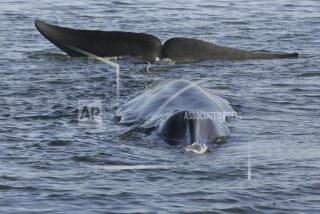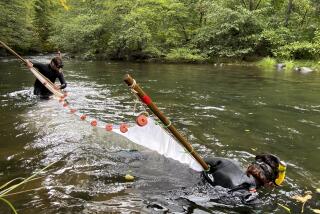Factory boats face cap on accidental salmon catch
SEATTLE — The giant factory fishing boats that take billions of pounds of pollock from Alaska’s Bering Sea would face major limits on salmon caught accidentally in their nets under controversial regulations recommended Monday.
The North Pacific Fishery Management Council endorsed rules intended to protect the steeply plummeting salmon stocks throughout the Pacific Northwest and guarantee more fish for villages across western Alaska. Villagers have seen their livelihoods vanish along with the valuable but threatened fish.
The $1-billion-a-year pollock industry fended off stronger limits advocated by villagers and conservation groups, warning that an early shutdown of fishing could cause devastating job losses and reduce Alaska’s tax receipts.
The council recommended a cap of 60,000 chinook caught accidentally -- known as a “bycatch.” In addition, the fishing industry agreed that it would try to meet an even lower limit of 47,591 salmon most of the time. If that voluntary limit were exceeded during any three years out of seven, the lower cap would become mandatory.
The U.S. secretary of Commerce will review the council’s recommendation and make the final decision.
Western Alaska villagers and conservation groups had sought to cap the accidental harvest at about 32,500 fish.
“It’s clear that the council could have done more to ensure that these salmon that are intercepted in the Bering Sea could get back to their spawning streams in western Alaska and the Pacific Northwest,” said Jon Warrenchuk, ocean scientist for the conservation group Oceana.
“Alaska is the last salmon stronghold in the world, and it’s about time we recognized that,” he said.
The pollock fleet consists of huge floating fish factories and other large trawlers that deliver tons of pollock at a time to processing plants largely in the Aleutian Islands. Pollock are flash frozen for fillets, fish sticks and artificial crab meat, and their roe is sold at a hefty price as a delicacy in Japan.
But the number of chinook caught accidentally in the massive nets has risen sharply in recent years, from 46,993 in 2003 to a high of 121,704 in 2007.
That number fell significantly last year, to 19,928, in what fishing company officials say could be testimony to the industry’s stringent voluntary efforts to reduce the accidental salmon harvest.
But others worry that the bycatch may have dropped because the overall numbers of fish have declined.
“At the same time this bycatch has been going up, the abundance of pollock has been going down,” Warrenchuk said.
Pollock-fishing executives warned the council that halting pollock fishing once any bycatch limit were exceeded would drastically affect the economy and the amount of cheap, edible protein available to feed a hungry world.
“In terms of food production alone, every 1,000 tons of foregone pollock catch equates to approximately 2.4 million meals of low-cost seafood that would otherwise be available to U.S. and other consumers around the world,” Seattle-based American Seafoods Co., one of the biggest of the pollock fishing fleet owners, told the council in written comments.
The industry has advocated a voluntary financial incentive program to lower the salmon bycatch.
Myron Naneng, president of the Assn. of Village Council Presidents, a Bethel, Alaska-based organization representing native villages dependent on salmon fishing, said the proposed cap was necessary but too high.
Rural fishermen recently have been prevented from harvesting chinook commercially because the salmon population has declined. Villagers have been forced to give up much of the traditional subsistence fishing that has fed their families for generations.
“In light of the dismal forecasts they have for Yukon River kings [chinook] for 2009, they should at least have pursued a substantially lower number,” Naneng said.
“Right now, they place the burden of conservation of the salmon on those people who live on the river systems, on those who have to gather it for food and resources.”
--
More to Read
Sign up for Essential California
The most important California stories and recommendations in your inbox every morning.
You may occasionally receive promotional content from the Los Angeles Times.










